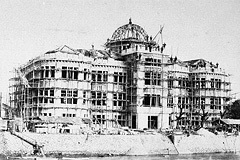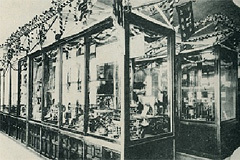Before the Atomic Bombing
Construction of the Hiroshima Prefectural Commercial Exhibition Hall
In the late Meiji Era, rapid development of modern industry driven by military demand supplemented Hiroshima’s traditional industries. Triggered in particular by the Russo-Japanese War that began in 1904, huge volumes of military products procured locally stimulated Hiroshima’s economy. This economic development led to the need for a base from which to expand sales routes, improve product quality, and develop new products capable of succeeding in an intensely competitive domestic business climate.
The original building that later became the Atomic Bomb Dome was designed by Czech architect Jan Letzel, constructed by Mukuda-gumi as a contractor of the work, and completed as the Hiroshima Prefectural Commercial Exhibition Hall in April 1915.
The building was constructed of brick and partially steel-framed, with the outer wall made of stone and mortar. The building was three stories high and contained multiple windows, with a five-story central stair hall capped by an oval copper dome (major axis approx. 11 m, minor axis approx. 8 m, height approx. 4 m). The first floor was mainly used for offices, and the second and third floors were used as display halls. The garden was approximately 1,650 to 1,980 m2 in width and contained many trees. It included a Western-style garden containing a pond with a fountain jetting water out from eight directions, and a Japanese-style garden with a gazebo. The building covered an area of 1,023 m2 and the display hall an area of 2,046 m2.
At the time, most buildings in central Hiroshima were two-story wooden structures; the bold European architectural design of the Commercial Exhibition Hall was extremely rare, making the advent of the building surprising for Hiroshima citizens. The building’s design, combined with the beauty of its reflection in the river, made the building one of the most famous places in Hiroshima.
The hall served many purposes, such as a place to collect and display products from Hiroshima Prefecture and other prefectures, to carry out consultation and research regarding commerce and industry, to browse books, newspapers, and magazines related to the introduction of trade, and for design consultation.
The hall served an important role in Hiroshima not only by stimulating industry, but for cultural promotion as well, providing a venue for a museum and artwork collection.
The name of the hall was changed to Hiroshima Prefectural Product Exhibition Hall in 1921, then to the Hiroshima Prefectural Industrial Promotion Hall in 1933.

Hiroshima Prefectural Commercial Exhibition Hall under construction (Photo: Hiroshima Municipal Archives)

Hiroshima Prefectural Products Promotion Fair at the Commercial Exhibition Hall in 1915 (Photo: Hiroshima Municipal Archives)
Use of the building before the bombing
As the war progressed, the hall came to be increasingly used for industrial promotion,with the size of the exhibitions decreasing as the severity intensified. Finally in March 31, 1944, the hall’s purpose was directed away from promotional activities, and the hall came to be used as an office for public agencies and control unions such as the Interior Ministry’s Chugoku-Shikoku Public Works Office and the Hiroshima District Lumber Control Corporation.
Inquiries regarding this page
Park Development Division
Urban Development Bureau
Phone:082-504-2393/Fax:082-504-2391
Mail:[email protected]
